Lipopolysaccharide disrupts the milk-blood barrier by modulating claudins in mammary alveolar tight junctions
- PMID: 23626786
- PMCID: PMC3633878
- DOI: 10.1371/journal.pone.0062187
Lipopolysaccharide disrupts the milk-blood barrier by modulating claudins in mammary alveolar tight junctions
Abstract
Mastitis, inflammation of the mammary gland, is the most costly common disease in the dairy industry, and is caused by mammary pathogenic bacteria, including Escherichia coli. The bacteria invade the mammary alveolar lumen and disrupt the blood-milk barrier. In normal mammary gland, alveolar epithelial tight junctions (TJs) contribute the blood-milk barrier of alveolar epithelium by blocking the leakage of milk components from the luminal side into the blood serum. In this study, we focused on claudin subtypes that participate in the alveolar epithelial TJs, because the composition of claudins is an important factor that affects TJ permeability. In normal mouse lactating mammary glands, alveolar TJs consist of claudin-3 without claudin-1, -4, and -7. In lipopolysaccharide (LPS)-induced mastitis, alveolar TJs showed 2-staged compositional changes in claudins. First, a qualitative change in claudin-3, presumably caused by phosphorylation and participation of claudin-7 in alveolar TJs, was recognized in parallel with the leakage of fluorescein isothiocyanate-conjugated albumin (FITC-albumin) via the alveolar epithelium. Second, claudin-4 participated in alveolar TJs with claudin-3 and claudin-7 12 h after LPS injection. The partial localization of claudin-1 was also observed by immunostaining. Coinciding with the second change of alveolar TJs, the severe disruption of the blood-milk barrier was recognized by ectopic localization of β-casein and much leakage of FITC-albumin. Furthermore, the localization of toll-like receptor 4 (TLR4) on the luminal side and NFκB activation by LPS was observed in the alveolar epithelial cells. We suggest that the weakening and disruption of the blood-milk barrier are caused by compositional changes of claudins in alveolar epithelial TJs through LPS/TLR4 signaling.
Conflict of interest statement
Figures


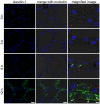
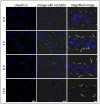
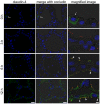
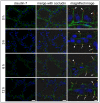

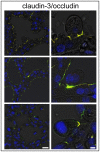

Similar articles
-
Altered expression of tight junction proteins in mammary epithelium after discontinued suckling in mice.Pflugers Arch. 2012 Feb;463(2):391-8. doi: 10.1007/s00424-011-1034-2. Pflugers Arch. 2012. PMID: 21975594
-
Distinct behavior of claudin-3 and -4 around lactation period in mammary alveolus in mice.Histochem Cell Biol. 2011 Nov;136(5):587-94. doi: 10.1007/s00418-011-0863-6. Epub 2011 Sep 13. Histochem Cell Biol. 2011. PMID: 21912970
-
Prolactin and glucocorticoid signaling induces lactation-specific tight junctions concurrent with β-casein expression in mammary epithelial cells.Biochim Biophys Acta. 2016 Aug;1863(8):2006-16. doi: 10.1016/j.bbamcr.2016.04.023. Epub 2016 Apr 26. Biochim Biophys Acta. 2016. PMID: 27130254
-
[Physiological Functions of Claudins].Gan To Kagaku Ryoho. 2024 Nov;51(11):1095-1099. Gan To Kagaku Ryoho. 2024. PMID: 39648120 Review. Japanese.
-
The Claudins: From Tight Junctions to Biological Systems.Trends Biochem Sci. 2019 Feb;44(2):141-152. doi: 10.1016/j.tibs.2018.09.008. Epub 2018 Oct 25. Trends Biochem Sci. 2019. PMID: 30665499 Review.
Cited by
-
Overexpression of lncRNA H19 changes basic characteristics and affects immune response of bovine mammary epithelial cells.PeerJ. 2019 Apr 5;7:e6715. doi: 10.7717/peerj.6715. eCollection 2019. PeerJ. 2019. PMID: 30984483 Free PMC article.
-
Claudin Proteins: Their Potential Role in Obesity and Adipose Tissue Signaling, Physiology and Disease.Nutrients. 2025 Aug 12;17(16):2611. doi: 10.3390/nu17162611. Nutrients. 2025. PMID: 40871639 Free PMC article. Review.
-
Investigating mammary glands of lactating goats for the presence of tertiary lymphoid organs.Front Immunol. 2022 Aug 10;13:941333. doi: 10.3389/fimmu.2022.941333. eCollection 2022. Front Immunol. 2022. PMID: 36032165 Free PMC article.
-
NDRG2 regulates adherens junction integrity to restrict colitis and tumourigenesis.EBioMedicine. 2020 Nov;61:103068. doi: 10.1016/j.ebiom.2020.103068. Epub 2020 Oct 21. EBioMedicine. 2020. PMID: 33099085 Free PMC article.
-
The gut microbiota contributes to the development of Staphylococcus aureus-induced mastitis in mice.ISME J. 2020 Jul;14(7):1897-1910. doi: 10.1038/s41396-020-0651-1. Epub 2020 Apr 27. ISME J. 2020. PMID: 32341472 Free PMC article.
References
-
- Akers RM, Nickerson SC (2011) Mastitis and its impact on structure and function in the ruminant mammary gland. J Mammary Gland Biol Neoplasia 16: 275–289. - PubMed
-
- Spencer JP (2008) Management of mastitis in breastfeeding women. Am Fam Physician 78: 727–731. - PubMed
-
- Barlow J (2011) Mastitis therapy and antimicrobial susceptibility: a multispecies review with a focus on antibiotic treatment of mastitis in dairy cattle. J Mammary Gland Biol Neoplasia 16: 383–407. - PubMed
-
- McFadden TB, Akers RM, Capuco AV (1988) Relationship of milk proteins in blood with somatic cell counts in milk of dairy cows. J Dairy Sci 71: 826–834. - PubMed
-
- McFadden TB, Akers RM, Kazmer GW (1987) Alpha-lactalbumin in bovine serum: relationships with udder development and function. J Dairy Sci 70: 259–264. - PubMed
Publication types
MeSH terms
Substances
LinkOut - more resources
Full Text Sources
Other Literature Sources

